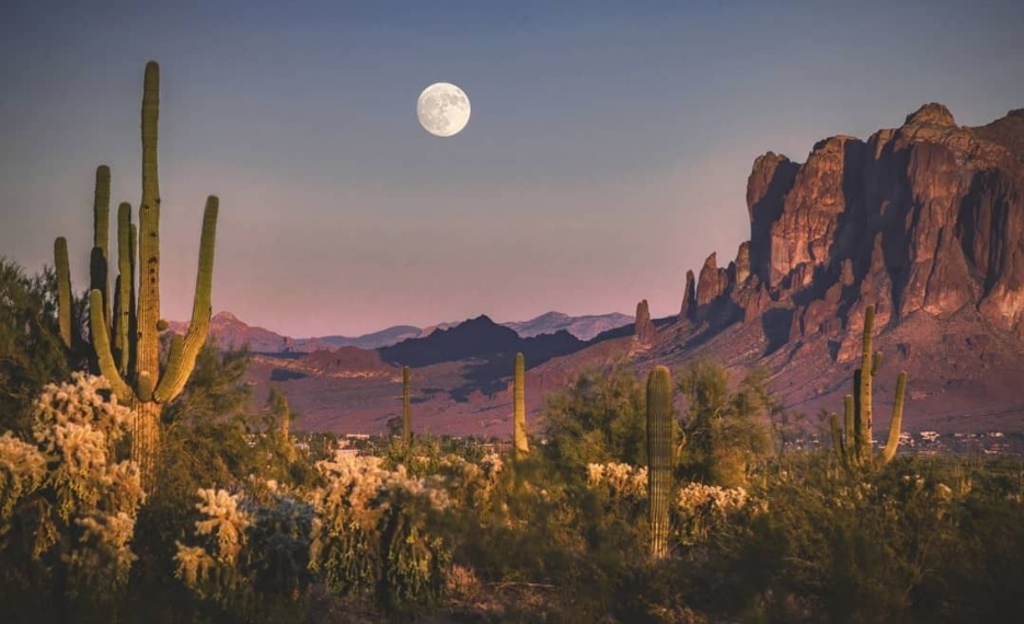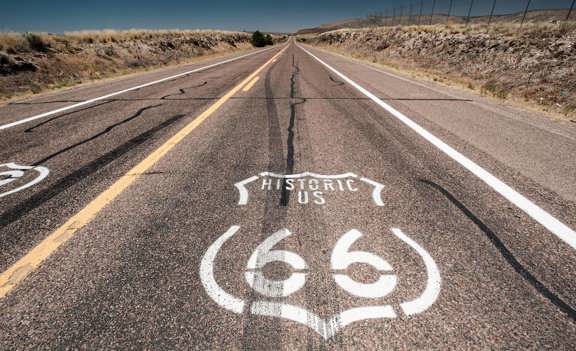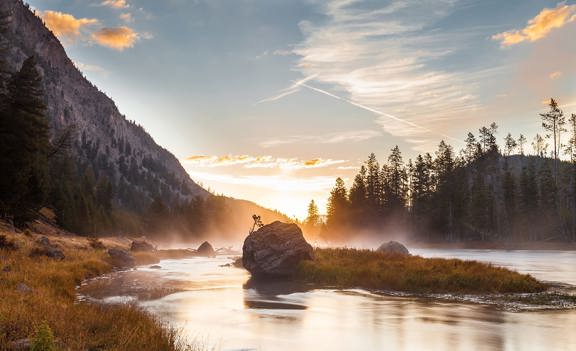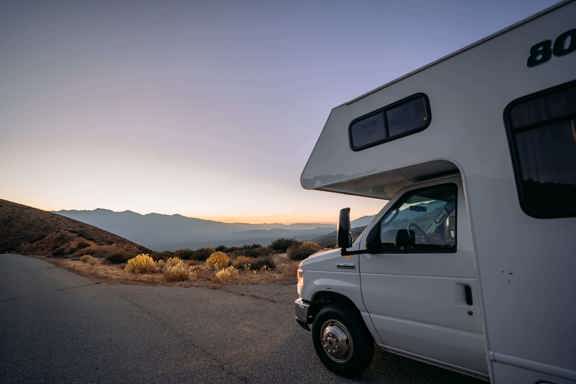
Arizona is a state where the landscape itself tells the story of thousands of years of human resilience and adaptation. Each site we highlight offers a window into the past, whether it’s the ingenuity of the Hohokam irrigation canals or the artistry of Puebloan masonry.
Exploring Arizona’s historical landmarks isn’t just about visiting ruins; it’s about walking through stories of survival, community, and cultural exchange that continue to shape the region today. And with wide open highways connecting these treasures, the best way to see them all is on a road trip that lets you set your own pace.
1. Spanish National Historic Trail
The Old Spanish Trail is often called “the longest, crookedest, most arduous pack mule trail in the history of America.” Active between 1829 and 1848, this route linked Santa Fe with Los Angeles, carving a vital trade path during Mexico’s frontier period. Merchants, trappers, and later Mormon settlers followed its twisting branches, including the Armijo Route and the mountainous North Branch, moving everything from wool and livestock to supplies for California’s Gold Rush.
For Arizona, the trail’s significance lies in its crossing through the state’s extreme northwest corner, a reminder of how geography shaped commerce and culture. Today, the Old Spanish National Historic Trail, recognized in 2002 as a National Historic Trail, invites modern visitors to trace these historic paths, reflecting on the grit and determination it took to move goods and people across the unforgiving Southwest.
2. Tumacácori National Historical Park
Tumacácori preserves the ruins of Spanish colonial missions founded along the Santa Cruz River Valley in the late 1600s. Established by Jesuit missionary Father Eusebio Kino, the mission became part of a network designed to convert and settle Indigenous communities, particularly the O’odham people.
The site reflects the blending of Spanish, Indigenous, and later Mexican cultures that shaped southern Arizona’s colonial frontier. The main church, never fully completed, stands as a striking adobe ruin surrounded by orchards and historic cemeteries. Take the self-guided walking tour to explore the mission grounds and attend seasonal cultural demonstrations that showcase traditional crafts, Native American art, and foods.
3. Orpheum Theatre
The Orpheum Theatre is an excellent example of Spanish Baroque architecture and Arizona's cultural history. Originally part of the nationwide vaudeville Orpheum Circuit, the Phoenix location opened its doors in 1929 with ornate design flourishes that immediately made it a city landmark. Over the decades, the theatre shifted ownership and names, even falling into disrepair by the mid-20th century.
In 1984, the City of Phoenix stepped in, purchasing the building and committing to a $14 million restoration that spanned more than a decade. By 1997, the theatre had regained its former glory, offering a glimpse into the golden age of live entertainment. Today, the Orpheum hosts concerts, stage productions, and special events, making it both a historic site and a cultural venue.
4. Wupatki National Monument
Rising from the high desert just north of Flagstaff, Wupatki National Monument safeguards more than 2,600 ancestral Puebloan sites. The history of Wupatki is closely tied to the eruption of Sunset Crater Volcano around 1085 CE. When lava and cinders blanketed the surrounding valleys, families were forced to abandon the fertile lands they had cultivated for centuries.
Yet, out of this upheaval came opportunity. Roughly eighty years later, new communities flourished in the northeast where lighter layers of volcanic ash actually helped retain soil moisture, making farming more productive in an otherwise arid environment. Ancestral Puebloans transitioned from small, scattered pit houses to multi-story masonry pueblos. The largest, Wupatki Pueblo, constructed in the early 1100s, rose three stories high with thick double walls filled with rubble for stability.
The Puebloans developed ingenious farming techniques, including dryland methods, terraces, and stone check dams to trap precious rainfall, as well as stone alignments to protect crops from sun and wind.
The visitor center introduces travelers to the rich history of the pueblos with exhibits and interpretive displays. From there, several trails allow for close exploration:
-
Wupatki Pueblo Trail: A 0.5-mile loop leading through the largest ruin, offering a 30-minute self-guided tour.
-
Lomaki Pueblo Trail: A 0.5-mile loop with three structures (currently being updated for accessibility).
-
Citadel and Nalakihu Trail: A short 0.2-mile hike up a cinder hill to defensive ruins with panoramic views.
-
Wukoki Pueblo Trail: A 0.2-mile loop highlighting a striking three-story tower.
Visiting all four main pueblos takes about two hours. Trails are partially accessible, with improvements ongoing.
5. Montezuma Castle National Monument
Contrary to its name, Montezuma Castle has no connection to the Aztec emperor. Instead, it is a remarkably well-preserved cliff dwelling built by the Sinagua people around the 12th century. The five-story structure, tucked high into a limestone cliff, contained about 20 rooms and offered both protection and efficient use of the desert environment.
Its strategic location near Beaver Creek provided access to water and fertile soil, sustaining the community for centuries before it was abandoned in the 1400s. The paved loop trail makes it easy for all visitors to view the cliff dwelling, and there's shaded benches with spots to admire the ingenuity of the builders and imagine the ancient Wild West.
6. Grand Canyon
Grand Canyon National Park is one of the most iconic landscapes in the United States and has been a UNESCO World Heritage Site since 1979. The Grand Canyon was carved over millions of years by the Colorado River. It stretches nearly 277 miles long, plunges more than a mile deep to the canyon floor, and reveals a cross-section of Earth’s history unmatched anywhere else on the planet. Layer upon layer of colored rock tells a story that spans nearly two billion years.
In 1919, the canyon was officially designated as a national park, the 15th in the United States, and is managed by the National Park Service. This marked a pivotal step in protecting its ecosystems, archaeological sites, and extraordinary vistas for future generations. Today, the Grand Canyon is not only considered one of the Wonders of the Natural World, but also one of the most visited national parks in the United States, drawing nearly five million visitors annually.
Its popularity stems not only from its dramatic overlooks but also from the wide range of experiences it offers, hiking along the South Rim, venturing into the canyon on the Bright Angel or South Kaibab Trails, rafting the Colorado River, or exploring the quieter and more rugged North Rim.
7. Hubbell Trading Post National Historic Site
Founded in 1878 by trader John Lorenzo Hubbell, the Hubbell Trading Post is the oldest continuously operated trading post in the Navajo Nation. It served as a crucial link between Navajo artisans and wider markets, exchanging wool, livestock, and woven goods for manufactured supplies.
Over time, the post became a cultural hub where Navajo traditions blended with Anglo-American commerce. Today, it remains both a working trading post and a preserved historic site, highlighting the resilience and creativity of the Navajo people. Browse the trading post store in Ganado, Arizona, where visitors can still purchase authentic Navajo rugs, jewelry, and crafts.
8. Fort Bowie
Fort Bowie was established in 1862 by the California Volunteers, but the fort rose to prominence following the Battle of Apache Pass, a violent clash between U.S. forces of the California Column and the Chiricahua Apache. For over 30 years, Fort Bowie and nearby Apache Pass functioned as the focal point of U.S. military operations in the region, its very existence bound to the long and often brutal Apache Wars. The culmination was the surrender of the famed Apache leader Geronimo in 1886.
In 1960, Fort Bowie and Apache Pass were declared National Historic Landmarks, recognizing their importance in U.S. history. Visitors to the Fort Bowie National Historic Site can walk among the preserved adobe ruins, explore remnants of the Butterfield Overland Stage Station, and reflect on the stories of the Native peoples.
Reaching the fort requires a 1.5-mile hike along Apache Pass Road, where interpretive signs guide visitors past key sites such as Apache Spring, the Butterfield Stage Stop, and Bascom’s Camp.
9. Casa Grande Ruins National Monument
Built by the Hohokam people during the Classic Period (1150–1450 CE), the Casa Grande Ruins preserve one of the most remarkable prehistoric structures in North America. The “Big House,” a four-story building made from caliche and adobe, has stood for more than seven centuries despite Arizona’s harsh climate.
Archaeologists believe the Hohokam engineered extensive irrigation canals and established far-reaching trade networks, connecting the Gila Valley to coastal and Mesoamerican cultures. Spanish missionary Father Eusebio Kino recorded the site in 1694, giving it the name “Casa Grande.” Stop at the modern protective shelter and visitor center in Coolidge, Arizona, to explore exhibits and view this great destination up close.
10. Chiricahua National Monument
Known as the “Land of Standing-Up Rocks,” Chiricahua National Monument protects towering hoodoos, pinnacles, and balancing stones created by volcanic eruptions 27 million years ago. Beyond its striking geology, the area carries cultural significance: it was once homeland to the Chiricahua Apache and later became the site of the Faraway Ranch, a frontier homestead run by Swedish immigrants Neil and Emma Erickson.
Established as a monument in 1924, the park preserves both natural and human history across its 17 miles of scenic trails. Begin at the Bonita Canyon Visitor Center and take the shuttle to Echo Canyon for a memorable hike among the hoodoos.
11. Sonoran Desert
The Sonoran Desert is one of the most biologically diverse deserts in the world, covering southern Arizona, parts of California, and extending deep into Mexico. It is home to the iconic saguaro cactus as well as unique ecosystems shaped by rugged mountains, narrow valleys, and seasonal rains.
The desert’s subdivisions, such as the Arizona Upland, support rich biodiversity with over 600 plant species and distinct “five seasons” that reveal subtle but important ecological rhythms. Indigenous communities and modern researchers alike recognize it as a place where desert and thornscrub ecologies overlap. You can explore the Arizona-Sonora Desert Museum in Tucson, which blends zoo, botanical garden, and natural history museum experiences to bring the desert’s story to life.
A Road Trip Itinerary to Arizona’s Best Historical Sites
Exploring Arizona’s history is best done on the open road. With wide desert highways, scenic byways, and plenty of space for adventure, an RV from Cruise America makes it easy to combine comfort with discovery.
Here’s a suggested route to experience all 11 of Arizona’s most fascinating historical sites:
-
Day 1–2: Phoenix
-
Day 3: Casa Grande Ruins National Monument
-
Day 4: Tumacácori National Historical Park
-
Day 5–6: Tucson & Sonoran Desert
-
Day 7: Fort Bowie National Historic Site
-
Day 8: Chiricahua National Monument
-
Day 9–10: Hubbell Trading Post
-
Day 11–12: Wupatki National Monument & Sunset Crater
-
Day 13: Grand Canyon National Park
-
Day 14: Montezuma Castle National Monument
-
Day 15: Return to Phoenix
Why Cruise America?
With flexible rental options, onboard kitchens, and the ability to camp near even the most remote monuments, a Cruise America RV ensures that your Arizona road trip is as comfortable as it is adventurous. Instead of rushing from hotel to hotel, you’ll have the freedom to immerse yourself in history on your own schedule.
RV Across The American West
Arizona’s historical sites showcase the depth and diversity of the American Southwest’s past. Visiting places like Wupatki, Casa Grande, Fort Bowie, and the Grand Canyon allows travelers to reflect on the ingenuity and perseverance of the people who called this land home. Explore stunning natural resources, an extended network of ancient communities, and much more.
To experience it all, consider hitting the road in comfort and style with Cruise America. Renting an RV gives you the freedom to explore these historic destinations at your own pace, combining adventure with convenience in one scenic drive.
Rent a Cruise America RV and see the beauty of Arizona for yourself.





